The stone in the ureter is an unpleasant problem for men. The cause of urinary disorders can be determined only by various methods of investigation. Also, pathology is accompanied by the formation of sand in the bladder. All these phenomena arise from various causes, and are accompanied by individual symptoms.

The etiology of stone formation is also different. There are several types of stones in the ureter. The release of the tumor from the bladder is also provoked by various causes. To understand how to avoid unpleasant pathology, you need to know the characteristics of the disease.
Etiology of the
problem The pathological process begins in the bladder. Initially, it accumulates urine, rich in salts. Salt leads to the formation of suspended matter in the liquid. The slurry gradually settles and accumulates. Glued particles of salt form small grains of sand. So sand is formed.
Further development of the disease provokes an increase in grains of sand in diameter. Gradual formation of stones occurs. They may differ in their etiology and form.
With urolithiasis, sometimes a stone appears in the urinary tract. This process is accompanied by a variety of symptoms. Elimination of pathology is accompanied by strict control by specialists. Therapy is performed in a stationary setting. After the disappearance of the causes of the pathology, the patient is discharged home.
Causes of the pathological process of
There are many causes that affect the formation and excretion of the stone into the ureter. The following pathological factors are distinguished:
-
 Inflammatory processes in the genitourinary system;
Inflammatory processes in the genitourinary system; - Features of the patient's residence;
- Irritating to environmental factors;
- Avitaminosis;
- Foods rich in acids;
- Increased salt content in drinking water;
- Different dehydration of the body.
The formation of stones is activated in the inflammatory process in the genitourinary system. Such diseases include cystitis, urethritis, prostatitis and other pathologies. With these diseases, swelling is formed in the organs. It involves the growth of tissues. The tissues begin to press on the lower part of the bladder. With urination, the bladder is not emptied completely. The urine stagnates. Formed stones.
Pathology accompanies people living in the southern part of the country. In hot climates the work of sweat glands intensifies. They begin to intensively remove fluid through the pores. This causes accumulation of salt in the bladder. Salt provokes the formation of sand and the further development of urolithiasis.
To the irritating environmental factors is the professional characteristic of a man. With a constant stay at the computer or in a standing position, there is a slowdown in metabolic processes in the body. Particularly to this process are the organs of the small pelvis. There is stagnation in them. Stagnant phenomena are accompanied by the presence of flakes in the urine. Flakes are gradually stuck together and form stones. Under the influence of various factors, their excretion into the ureter occurs. This process is accompanied by painful symptoms.
One of the reasons for the appearance of pathology is beriberi. The lack of certain vitamins in the body entails not the splitting of individual substances entering the bladder. With a high content of acids in the food, various salts accumulate. Salts cause accumulation of sand and further formation of stones. With a constant avitaminosis, they leave the bladder and enter the ureter.
Urolithiasis often accompanies dehydration of various etiologies. This phenomenon may occur when taking certain medications or prolonged absence of drinking. When the bubble is emptied, only liquid is discharged. Mineral substances remain on the walls of the urinary system. They form stones that can enter the ureter.
Symptoms of the pathological process
 Symptoms of urolithiasis are different. The following symptoms are signs of the presence of a stone in the ureter:
Symptoms of urolithiasis are different. The following symptoms are signs of the presence of a stone in the ureter:
- Soreness in the emptying of the bladder;
- Obstruction of urination;
- Feverish syndrome;
- Interruption of the flow of urine.
If a stone falls into the ureter, the patient appears soreness. The pain in this case has a variety of localizations. When a tumor enters the upper part of the ureter, an unpleasant symptom is revealed in the lumbar spine and perineal region. Also, after visiting the toilet, a man experiences a repeated urge to urinate.
If the stone is in the lower ureter, the pain occurs in the inguinal zone or in the lower abdominal cavity. With such a localization of the stone, complete overlapping of the ureter may occur. Urine during emptying will be difficult to excrete. For the complete emptying of the bladder, the man needs to make efforts. This phenomenon is also accompanied by an interruption of the jet. The resumption of urination occurs when the posture changes.
Prolonged accumulation of urine in the bladder in some cases is accompanied by an increase in body temperature. A person has a febrile syndrome. At this stage of the disease, urgent hospitalization is needed. Excretion of salts from the ureter should be carried out under the strict supervision of a specialist.
Diagnosis of pathology
The disease is always accompanied by characteristic features. To establish a diagnosis, a patient should undergo a medical examination. For the study, the patient takes the fluid from the bladder. A large amount of salts is found in the liquid. Sometimes you can find individual flakes. The urine of such men has a dark color. This is due to the high content of acids and blood impurities. Blood gets into the urine when the ureter is injured during emptying.
Also for the proper diagnosis it is necessary to undergo ultrasound examination. It will help to establish the presence of residual liquid in the cavity of the bladder and to determine the localization of the stone. If the stone has no sharp edges and is capable of gradual movement, a special therapy is prescribed to the patient. If the stone does not leave on its own, surgical intervention is performed.
Methods for the removal of education from the urinary system
There are two methods for removing stones from the ureter:
- Surgical;
- Medicated.
The medication method is used for stones that are not large in size and capable of being removed from the ureter independently. Initially, the patient is injected with an antispasmodic drug. It relieves stress from the ureter and relaxes its walls. In some cases, the removal of the stone occurs immediately after taking the drug. Further therapy includes the use of drugs that promote the cleavage of stones and sand. This will help to prevent the neoplasm from entering the ureter.
Surgical treatment is carried out in emergency cases. Modern doctors use a laser. It allows you to break the stone directly into the ureter. After surgery, the remains of the neoplasm are excreted in the urine.
Urolithiasis is a problem for modern men. Proper prevention can help avoid complications. In this case, the stone in the ureter is not found.



